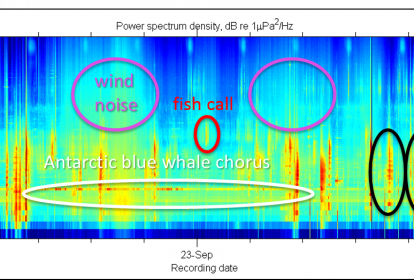Cetaceans depend on sound for their survival. It is their primary sense and essential for successful foraging, migration and reproduction. In recent years there has been a rapid growth in man-made (anthropogenic) ocean noise, generated from a range of sources including shipping, seismic exploration, drilling and construction.
Anthropogenic noise in the marine environment can be classed as either acute or chronic. Acute noise, such as seismic surveys or military sonar, is high in intensity, short in duration and often pulsed. Chronic noise refers to long term, low intensity noise, for example from shipping and industrial activity. Both have the potential to impact on cetacean behaviour and physiology.
In 2022 the IWC endorsed a workplan on anthropogenic ocean noise which is also highlighted as one of the priority threats in the Strategic Plan of the IWC Conservation Committee. In addition, Scientific Committee research is ongoing and aims to better understand the impact of noise on cetaceans, and the effectiveness of different approaches to reducing exposure.
In 2018, the Commission agreed by consensus, a Resolution that recognised the increasing concern over ocean noise, and clarified next steps in order to better understand and manage the threat.
Click here to read the 2018 Resolution on Anthropogenic Underwater Noise.
The IWC is raising the profile of this issue in other international fora including the United Nations consultative process on Oceans and the Law of the Sea (UNCLOS) and the International Maritime Organisation (IMO) where the IWC is actively engaged in IMO discussions on means to reduce underwater noise from shipping.
In recent years the IWC has also worked with other partner organisations on a range of noise-related initiatives. These include:
- working with governments, industry and the International Union for the Conservation of Nature (IUCN) to develop guidelines for mitigation and monitoring when conducting seismic surveys off Sakhalin Island in the Russian Federation, which is a primary feeding area for gray whales.
- a 2016 workshop focused on examining concerns related to the 'masking' effect of anthropogenic sound on cetaceans. Masking is the term used when other noise(s) block or 'mask' the sounds on which whales rely.
- co-sponsoring a 2014 workshop with the US National Oceanic and Atmospheric Administration (NOAA) CetSound project, to map cetacean soundscapes. The workshop was entitled Predicting Soundfields - Global Soundscape Modelling to Inform Management of Cetaceans and Anthropogenic Noise.
- facilitating an independent review of an unusual mass mortality of melon-headed whales that occurred in 2008.
Read more
To read the 2018 IWC Resolution on Anthropogenic Underwater Noise click here.
Click here to read the 2018 IWC submission to IMO's Marine Environment Protection Committee.
To read the 2018 IWC contribution to the UN Secretary General's Report on Oceans and Law of the Sea click here.
To read more about guidelines for mitigation and monitoring of seismic surveys click here.
To read the report of the 2014 workshop on cetacean soundscapes click here and to read more about the US NOAA's CetSound program click here.
To read the independent review of the 2008 melon-headed whale mass stranding in Madagascar click here.


